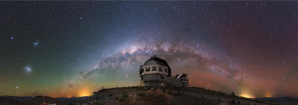UA Astronomers Use New Data to Weigh the Milky Way

Steward Grad Student Ekta Patel and Steward Assistant Professor Gurtina Besla are the lead authors of a study to use the best-available observational data and physically conserved quantities to place robust limits on the mass of the Milky Way. Ekta provides the following text:
"Calculating the mass of our galaxy precisely is important for our understanding of galaxy physics, but it is difficult to do since we live inside of the Milky Way. The current widely-accepted theory on the growth of structures in our universe is the cold dark matter theory. This theory predicts that Milky Way mass galaxies should host around 100-200 satellite galaxies, or galaxies that orbit other galaxies. Currently, we know of about 50 satellite galaxies orbiting our own, so one reason a precise mass estimate is useful is to test how well this theory matches our observations in the context of the satellite galaxy population.
Many values of the Milky Way's mass, including some 30-year-old results from Steward astronomers, have been published over the last few decades using different methods. In this work, we present a method that appears to be robust when we use the information available to us and we hope that it will be a way to move forward as the observational data sets continue to grow and as numerical simulations of the universe improve. This method focuses on using the orbital angular momentum of satellite galaxies rather than their position and velocity to construct a mass estimate for the Milky Way. The benefit of using angular momentum is that it is conserved over time, unlike position and velocity. This means that no matter where a satellite galaxy might be in its orbit around its host galaxy (i.e. closest approach or farthest distance), the method still proves to be reliable. The second benefit of our method is that we use the properties of eight or nine Milky Way satellite galaxies simultaneously, which helps in yielding a more precise estimate. As the properties of additional Milky Way satellites are measured, we will be able to revise our current Milky Way mass estimate, which is about 960 billion times the mass of the Sun."
The UA press release can be found HERE.
The cover photo had to be trimmed to fit. To see Yuri Beletsky's full-size photo of the Milky Way with two of its satellite galaxies (the two Magellanic Clouds), click here. To see many more of his photos, go HERE.

For Public
Public events include our Monday Night Lecture Series, world-reknowned Astronomy Camp and Mt Lemmon Sky Center.

For Students
A good place to start if you want to become an undergrad major or grad student, or need to find our schedule of classes.

For Scientists
Find telescopes and instruments, telescope time applications, staff and mountain contacts, and faculty and staff scientific interests.




